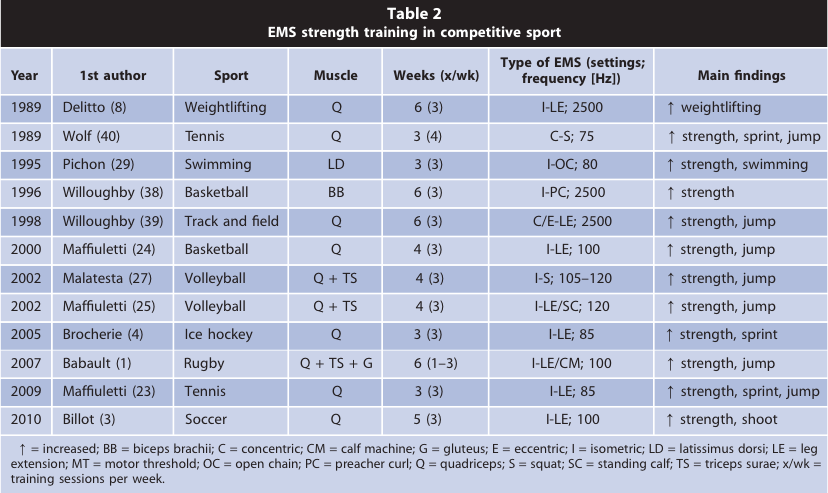Electric muscle stimulation (EMS), also known as neuromuscular electrical stimulation (NEMS) or percutaneous electrical stimulation (PES), is a method of eliciting muscle activity through applied electrical current. Your muscles naturally contract in response to electrical signals sent from your brain, and EMS replicates this with electrodes placed on the skin and a current run through them from a power source (Figure 1).

Figure 1. An example of an EMS unit with the electrodes (pads) placed on the quadriceps muscles
There are a couple of interesting physiological differences between a voluntary contraction through the central nervous system and an involuntary contraction through EMS. First, while a voluntary contraction will recruit smaller motor units and slow-twitch, Type-I fibers first and then activate the Type-II fibers as needed, an EMS contraction reverses this order. Because the involuntary contraction bypasses this neurological coordination, and because the applied current flows more easily through the larger neurons of the fast-twitch fiber, they are activated immediately, a response that is impossible to achieve through our own volition. Second, a voluntary contraction activates individual fibers in relays in order to conserve energy and not tire too quickly; EMS activates all of the motor units in the area at the same time, contracting all of the fibers with no holding back.
For much of the 20th century, EMS was used for orthopedic rehabilitation and physical therapy, specifically neuromuscular reintroduction and prevention of atrophy. However, it wasn’t until a Soviet scientist presented to the West in 1973 what Communist Bloc countries had been doing for 2o years: EMS as a method of strength training. Dr. Y. Kots of the Central Institute of Physical Culture in the USSR claimed to see up to 30-40% strength gains in already-trained individuals using specific methods of EMS, and while these results are quite extreme and have not been replicated in Western studies, the years of research since have shown that training with EMS leads to greater increases in isokinetic peak torque, maximal isometric strength, and maximal dynamic strength. However, a more useful way of looking at EMS is its effect on athletic performance – can it lead to improved performance, and is it a viable training option?

Figure 2. Table produced by Seyri & Maffiuletti in their review paper “Effect of Electromyostimulation on Muscle Strength and Sports Performance”
As seen in Figure 2, many studies have proven the efficacy of EMS in improving strength and jumping ability, and in some cases sprinting ability. The longest-running study from this paper was the 2007 study on elite rugby players, which lasted 12 weeks. A test group of 15 players went through two 6-week bouts (first 3 sessions/week, then 1 session/week) of EMS on the plantar flexors, knee extensors, and gluteus muscles, and a control group of 10 players received no training; both groups performed tests at 0, 6, and 12 weeks. The EMS group showed improvements compared to the controls not only in strength (squat, leg extension) but also in power (squat jump and drop jump height), an attribute more translatable to sport performance. The test group, however, saw no power increases after 6 weeks, only 12, and no improvement in sprint times over 12 weeks. The decision to change the training protocols halfway through the experiment does not discredit the results, but makes it more difficult to clearly see the relationship between protocol and result. The study on tennis players, at 4 weeks long, showed large improvements in maximum voluntary contractile force of the quadriceps and small, yet significant, improvements in sprint times and counter-movement jump heights. The study on soccer players, at 5 weeks long, showed the greatest improvements in strength and kicking power (measure by ball velocity) to come between weeks 3 and 5, with no improvements before week 3. It, however, demonstrated EMS to cause no changes to sprint ability.

Figure 3. A professional soccer player exerting force onto a soccer ball
While these studies and many others confirm the ability of EMS intervention to improve strength and in many cases other measures of power that relate to on-field performance, they do not compare EMS directly to a voluntary training program. The rugby study’s control group underwent no additional training, and the tennis and soccer studies had no control groups. They each could have had a group that underwent voluntary strength training in parallel to the other groups. The argument against this, though, is that a voluntary training program requires more time and effort that is in short supply for busy athletes; the tennis study mentioned the virtue of EMS for players with busy competitive schedules who don’t have the time for voluntary strength training. In this regard, it appears that EMS can be used as a tool to enhance athletic performance. However, the most valuable questions right now concern how to incorporate EMS with regular training programs, at different periods of athletes’ competitive schedules, to reap the greatest benefits of sport-applicable muscle function.
Recommended Further Reading
Is high-frequency neuromuscular electrical stimulation a suitable tool for muscle performance improvement in both healthy humans and athletes? (Review)
The Truth About EMS – Electronic Muscle Stimulation: Facts and Fallacies (good explanation of muscle physiology)
Questions to consider:
Have you ever used EMS? Was it for muscle recovery, neuromuscular reeducation, strength training, or as part of a sports-specific training program?
Would you or would you ever have spent $200 to $1000 on an EMS device that could give you an in-season advantage in your particular sport?





